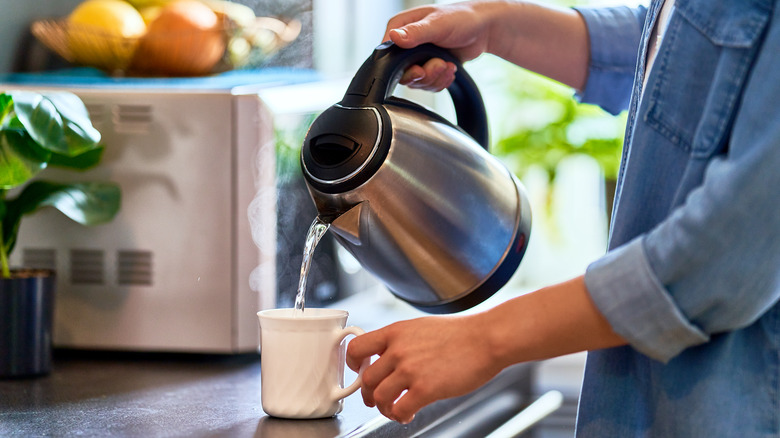Preheat Your Coffee Mug With Boiling Water For A Tastier Cup Every Time
When it comes to coffee, the U.S. is a nation obsessed. While America may run on Dunkin', there are just as many enthusiastic coffee lovers engaging in intricate at-home rituals each day to brew their perfect cup. And for those who fall into this category, enthusiasts know it matters a lot, thank you very much, exactly which steps they take — from the beans to the brewing method itself, the flavoring, the milks, and even the mug we drink it out of. It all contributes to the best possible brew.
While those with bougie at-home coffee rituals may think you have all the hacks you need to know for the perfect cup, every coffee lover has experienced the tragedy of said perfect cup turning cold before they can drink it — the common plight of busy parents and multi-taskers everywhere. Enter preheating your coffee mug. It's one easy step you might not yet be incorporating, but once you do, you'll never go back. Preheating your mug with boiling water before you pour your coffee into it won't improve a mediocre cup of joe, to be clear. It can be the difference, though, between a good-at-first cup of coffee that goes bitter before you can finish it, and a cup that stays as delicious as when it was just poured — at least for long enough to get you through your morning email inbox.
Let boiling water heat the mug for just a minute or two
Preheating your mug with boiling water ensures your favorite mug itself is piping hot as you pour your coffee into it, preventing the inevitable loss of heat that can occur when pouring steaming liquid into a chilly cup, which immediately cools off the liquid. Think of this hack as your daytime version of prechilling a martini glass in the freezer — just in reverse. And the process couldn't be easier or more foolproof — zero additional fancy equipment or skills needed.
While you're brewing your coffee, whether in your French press, pour-over, or coffee machine, boil a pot or kettle of water and grab your fave mug. This tip works in whatever vessel you're about to pour your coffee into though, even a travel thermos — though insulated containers are designed to stay warm, ideally without this extra step. When the water has reached a rolling boil, carefully fill your coffee mug and let it sit with the water in it for a couple of minutes, giving the heat a chance to thoroughly warm up the ceramic. Then pour out the water and fill your perfectly preheated container with piping hot coffee, and congratulate yourself on having hacked your way to a better cup, without having to upgrade to pricy insulated mugs or coffee cup warmers.
Why hot coffee that's gone cold tastes so bad
Ever wonder why a hot cup of coffee that's gone cold is — simply put — not the vibe, even though java lovers can't get enough of iced coffee, iced lattes, cold brews, and other intentionally cold coffee drinks? Hot coffee that's cooled down just doesn't taste the same as an intentionally chilly beverage. While it may seem unfair that one can't simply toss some ice cubes and a straw into a mug of hot coffee that they forgot about and proceed to enjoy, the dramatic shift in flavor can be explained with some basic science. In essence, when a hot cup cools down, a chemical process takes place. Naturally occurring chemicals in hot coffee called lactones shapeshift into carboxylic and chlorogenic acid, which are to blame for a dramatic increase in the coffee's acidity levels. Conversely, iced lattes or even bold cups of cold brew never go through this dramatic temperature fluctuation, which is why they taste well-balanced, not acidic.
This process is inevitable, and taking steps to reheat your lukewarm cup, like sticking it in the microwave, can actually only increase the bitter taste you're trying to avoid. However, preheating your mug will slow down the chilling process and keep your brew hotter (and tastier) for longer. If you still find yourself with a cold cup you didn't get to enjoy fast enough — it happens to everyone sometimes — avoid the microwave. Instead, the best way to reheat your coffee is actually on the stovetop.


